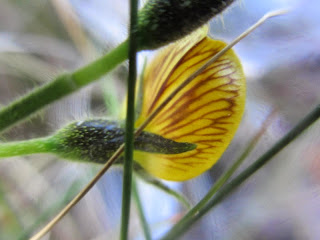Yes, it's Pippa's birthday! Many Happy Returns!
Remember the plastic snake in the garden last week? Well it's back in the cupboard in disgrace, but there's nothing plastic about this African Goshawk Accipiter tachiro which I spotted (and Andre kindly identified) as I climbed into the car on Thursday evening:
It is said to like dense cover from which to hunt, here it is in the old Crab Apple. It flew in from my right, gave me a quick opportunity to take two photos before flying off to my left, across the garden. Maybe it found supper on the way?
We went to look at the Struthiola and Viola which we found last week. We particularly wanted to check the leaves of the Struthiola to identify which one it is.
The narrow rosemary-like leaves lie close to the stem and the flowers are borne in the axils, towards the end. It certainly looks like Struthiola ciliata or Evening Gonna, or The Lady Passes By in the Night, for its evening perfume!
We've seen this plant occasionally before, a twining creeper with long tendrils and these white flowers at random along the stems. We've only now identified them as Cyphia volubilis or Klim-op. They are of the Lobelia family and the Khoi name which is often used is Baroe.
Anina has kindly identified this Restio (again, we've seen it before) as a Hypodiscus argenteus male:
Flower detail:
...... and this magnificent one, unfortunately the flowers are past their best, as (probably) an Elegia mucronata male. She says, 'This one is quite spectacular in flower and grows at altitude in damp patches.' The stems would make good canes and the remaining stems of the flowers look a bit like corkscrews!
There are still splashes of pink in the veld from different kinds of low-growing Ericas. I thought the next two pictures were of the same variety, but looking at them now, the top one is pink......
.... and the lower one is lilac!
Remember Elton John hopping and bopping to the Crocodile Rock?
This was today's 'find', Tar Pea Bolusafra bituminosa:
The veins on the back of the petals are exquisite!
Here seen twining along the stem of a Pelargonium, in fact it had climbed along all of its stems!
While on the subject of our unusual rocks, here in the distance is one we call Madonna and Child.
This one has been strangely eaten away with deep holes:
.... one of which these Ladybirds have found ideal for a nest!
We don't often see Brunias in full flower like this!
Another Struthiola on the way home:
And an Arum Lily Zantedeschia aethiopica in a stream:
:-) A



















Some good photos of the natural world, what a good photo of the Goshawk, the grasses sadly I am not into even though for a while I worked with seeeds in the UK, never-the-less very interesting. As for the flowers the ever liked Ericas and the Arum Lily which is now a very common plant in the Northern Hemisphere.
ReplyDeleteAlso the rock formations I found interesting, lovely to see the ladybirds thriving in that part of the world.
Tar Pea? we have a pretty common European Tar Plant, was Psoralea now Bituminaria bitiuminosa but that is a striking puple plant, useless comment really I suppose. Thanks Andy for a piece of South Africa again, magic.
We do have a Psoralea, but it's the pinnata. Thanks Bernard for your comments!
Delete